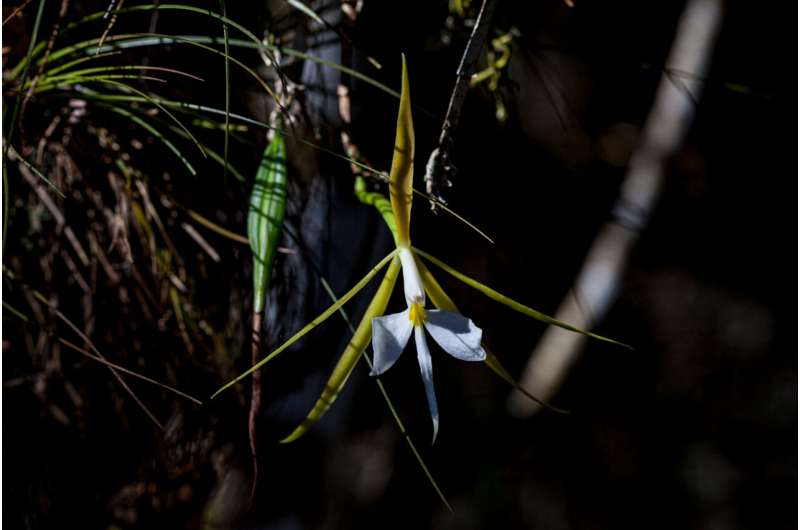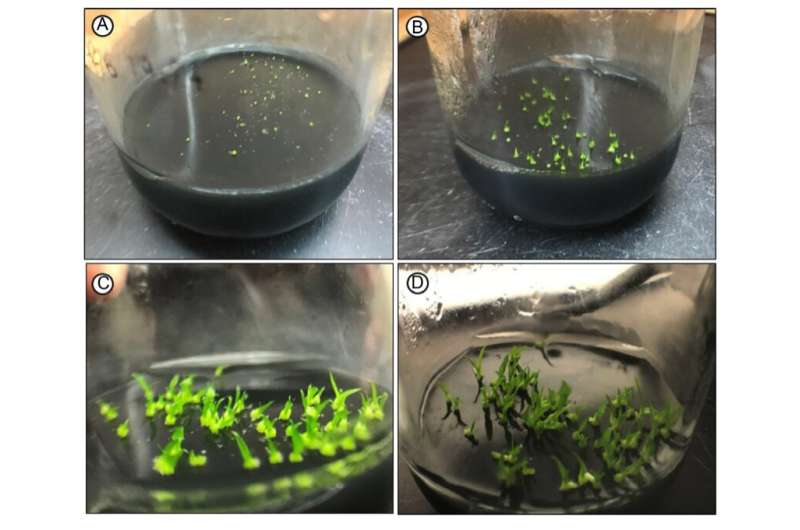This article has been reviewed according to Science X's editorial process and policies. Editors have highlighted the following attributes while ensuring the content's credibility:
fact-checked
trusted source
proofread
Rare orchids could be saved by common fruits in Florida, research finds

Florida's night orchid is at risk of extinction, but backyard fruit trees could hold the key to their survival.
Orchid growers often rely on expensive propagation techniques to increase plant populations using costly, synthetic plant growth regulators/hormones (PGRs). For the first time, scientists have used a mix of natural products found locally to propagate Epidendrum nocturnum—a rare fragrant orchid that only blooms at night in Florida.
Florida International University horticulturist Amir A. Khoddamzadeh and a team of scientists developed the protocol for in-vitro micropropagation and acclimatization using coconut water, banana powder and potato dextrose to induce the growth of cells in Petri dishes.
"There are very limited studies on using the organic-based PGRs in the tissue culture process and none specifically on South Florida's native orchids," said Khoddamzadeh, lead principal investigator for FIU's Conservation and Sustainable Horticulture Lab. "Industrial nurseries haven't used organic PGRs often as a regular additive in the media. We established a protocol that can be used by botanical gardens and nursery producers."

Many plants in tropical and subtropical climates do not propagate through seeds, so propagation using plant tissue culture is an important method for increasing the number of plants. Current in-vitromicropropagation methods typically involve several grams of the synthetic PGRs to regulate growth and developmental processes in tissue culture, Khoddamzadeh said. These synthetic chemicals can cost $300 to $800 per 100 grams. In large nurseries, the chemicals may be gone in just one batch of culture jars.
Khoddamzadeh initially looked at the media used in tissue culture and the addition of inexpensive organic materials. He took a seed pod collected from the Fairchild Tropical Botanic Garden and placed it in the petri dish with coconut water, banana powder and potato dextrose which served as PGRs. These additives shocked the cells and produced induction, which increased the number of shoots, roots and leaves.
For Fairchild Tropical Botanic Garden in Miami, Fla. and its Million Orchid Project—the nation's largest educational outreach program dedicated to orchids—this propagation alternative could be a game-changer for orchids grown there and in commercial nurseries. Khoddamzadeh and his lab collaborate with Fairchild biologist and FIU alumnus Jason Downing on this initiative.
This study was published in the American Journal of Plant Sciences. Khoddamzadeh is also the editor of a special issue in Plants on "Micropropagation, Acclimatization and Genebanking of Horticultural Crops," which will focus on the different aspects of conservation horticulture and plant biotechnology.
More information: Douglas De Stefano et al, In-Vitro Micropropagation and Acclimatization of an Endangered Native Orchid Using Organic Supplements, American Journal of Plant Sciences (2022). DOI: 10.4236/ajps.2022.133023
Provided by Florida International University

















